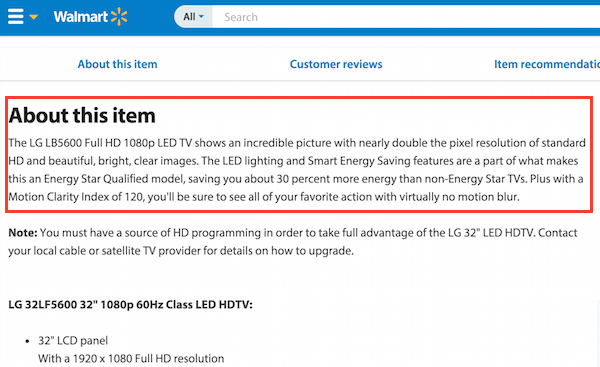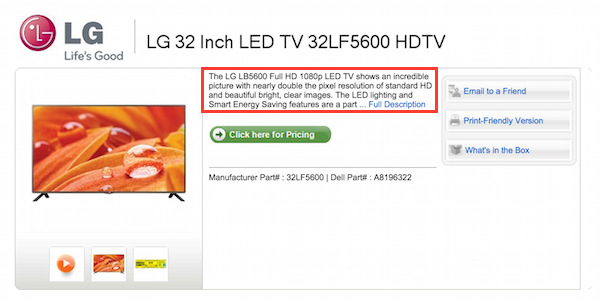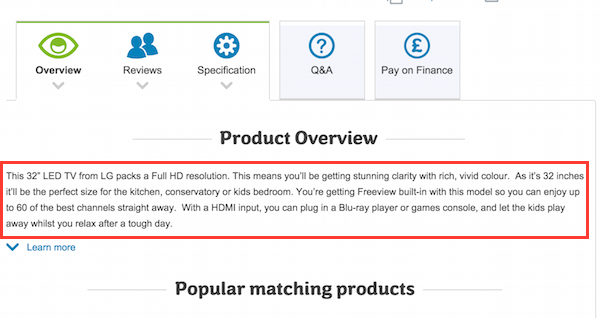9 Valuable Tips for Your Ecommerce Product Page Copy
The written content on e-commerce product pages grabs the attention of consumers and influences SEO ranking. These nine pointers will help improve the quality of your copy strategy.
The written content on e-commerce product pages grabs the attention of consumers and influences SEO ranking. These nine pointers will help improve the quality of your copy strategy.
Great copywriting for e-commerce can make a big difference for conversions and can play a role in terms of SEO.
It isn’t as simple as listing products and using the manufacturer’s product description. Attention should be paid to ensure that the copy works hard to increase search visibility as well as persuading customers to buy.
Here are some key pointers.
These product descriptions are used by lots of sites that sell the same products, and it seriously affects the product’s ability to rank well on search engines. It also looks less genuine to shoppers.
For example, Walmart uses the manufacturer’s description for this LG TV:

And so does Dell:

Ultimately neither site ranks highly on a search for this product. This could be due to a number of reasons, but this certainly doesn’t help. Instead the manufacturer is top, followed by lots of reviews, sites, videos, and Amazon.
From a customer perspective, original copy works better and is more useful to customers than the generic product description. Phrases like “motion clarity index” may seem like meaningless sales jargon to many, indicating to consumers that the people behind the website don’t have any knowledge about the product.
Compare the previous examples of product descriptions to that of AO.com – this is another LG model, but this product description definitely more original:
 This version is more organic. By explaining the features without resorting to jargon, this gives the impression that the person writing the copy has actually used the product. Moreover, this is unique content that the search engines can index.
This version is more organic. By explaining the features without resorting to jargon, this gives the impression that the person writing the copy has actually used the product. Moreover, this is unique content that the search engines can index.
Search keyword referral data is now very rare, but e-tailers can use site search data to gain valuable insight into the kinds of terms and language customers use to describe and search for products. The keywords that people use to search within your website for products or information are very likely to be the same keywords they use when they are searching on Google, Bing, or other search engines. Then this can be incorporated into the product’s meta data and the product descriptions, so that the copy can also reflect how customers are likely to search for products.
Web users like to scan pages and won’t necessarily delve into the text of product descriptions to pick out key features. This is why it helps to display the key points clearly.
Note how Best Buy lists and explains the features of a drone in a way that makes it easier for users to scan quickly:

Products like laptops and cameras require the display of lots of detail – memory size, processing power, zoom, and so forth. This must be displayed in a way that makes it easy for customers to understand.
Formatting is important here, as customers should be able to scan to see the features and specifications that matter to them.
Here, Newegg presents the specifications for a laptop:

Another useful feature is the ability to compare different products and their specifications side-by-side, as demonstrated here on PC World:

The type of product, price points, and complexity should be taken into account when considering how much information the customer is likely to need in order to make a purchase. For instance, a simple product such as a tie requires very little detail.
Ties.com presents information on color, size, and material. The rest is left to the product imagery:

Anticipate and deal with likely questions. Use data from customer service and sales teams to provide the most important data prominently.
Some sites have user-generated Q&A sections that allow customers to answer each other’s questions.
Here’s an example from Newegg:

These user-generated Q&A sections should also help to tell retailers more about consumers’ concerns and help improve product copy in future.
If your products are popular, your service is great and customers are saying so. Make sure people see this on your product pages.
Reviews are the most obvious example of social proof. They essentially allow users to wax lyrical about your products if they’re happy with them.
Here’s a great example from Modcloth on one of its product pages:

Product copy should reflect the company’s tone of voice, as well as being appropriate to the product sold. Copywriters should be able to adapt their writing style easily to suit the company’s tone of voice, while ensuring that SEO objectives are taken care of.
You can always rely on J. Peterman for quirky and original product copy, which perfectly matches the brand. It’s also pretty entertaining:

This is something to test as the relative importance of various product page elements will differ between sites, products, and audiences. Many sites tend to prioritize product imagery over all else.
Jimmy Choo does so here, with the description one of the less prominent features on the page:

However, some sites work a little harder for big ticket items.
For example, this chair from Crate & Barrel is $1,600, and some customers need the copy to explain why it costs this much.

Therefore, the copy emphasizes the quality of the material and the processes and the longevity of the product.
There’s no magic formula for great product page copy, but there are certainly some key mistakes to avoid, such as using generic descriptions for products.
The copy must be compelling and persuasive and spell out the key features of products, while remaining close to the brand tone of voice.
After that, presentation of copy is very important. Users scan pages for key details so it’s important to highlight product USPs and key features for such users.
Which sites do you think are creating great product copy? I’d love to see your suggestions…